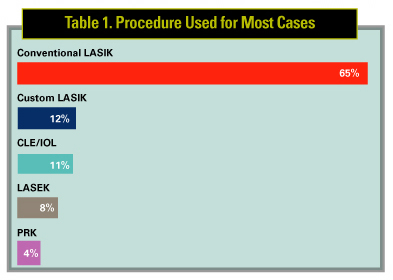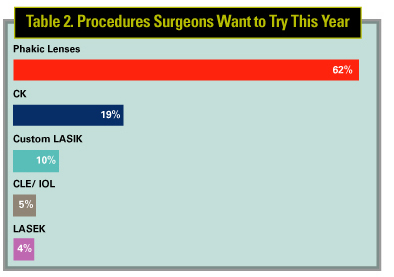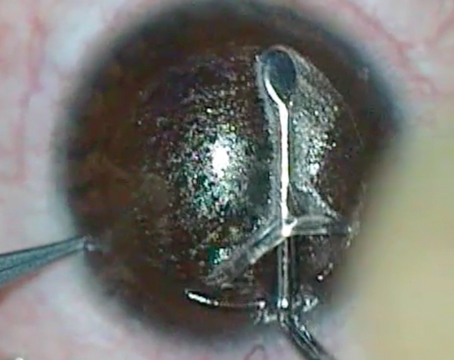According to the refractive surgeons on our National Panel, familiarity doesn't always breed contempt. Now that they've had some more time to work with custom LASIK systems, they say they're using them more frequently. They're still not convinced that conventional LASIK is all that bad, however. Away from the cornea, they're also very eager to begin using phakic intraocular lenses for certain refractive patients.
These are some of the results from this month's National Panel Report on refractive surgery. This month, 56 surgeons, or 7 percent of the 750-surgeon sample, responded. Here is what they had to say.
Preferred Procedures
Forty-seven percent of the panelists perform refractive surgery, and when asked which procedures they perform, most of these (84 percent) say they do LASIK (more than one response was possible). Most of the refractive surgeons (80 percent) say they perform five to 20 LASIK cases per month. Sixty-nine percent perform PRK.
 |
Sixty-one percent say they do custom LASIK on occasion, which is an increase from 26 percent in last July's survey. The refractive surgeons estimate that an average of 31 percent of their cases are custom.
"I like having the exact 'fingerprint' of the eye," says Warren, Mich., surgeon Michael Solomon.
R. Scott Russell, MD, of Flushing, N.Y., also likes custom LASIK's results. "[Custom] gives an improved quality of visual acuity, better contrast sensitivity and often better visual acuity," he says.
Some surgeons, though they perform custom ablations, aren't completely sure they provide a world of difference in terms of results. "I've not felt the need to add custom," says Seattle surgeon Richard Bensinger. Sidney Seltzer, MD, of Charleston, S.C., agrees: "I'm not sure custom is better." A Texas surgeon would like to see better outcomes from wavefront-guided treatments, noting that, "They can't remove higher-order aberrations."
The refractive respondents charge, on average, $1,739 for LASIK, and mark it up an average of $325 if the procedure is wavefront-guided. The average of their LASIK facility fees is $609.
 |
When asked to choose the procedure they use for most of their cases, 65 percent of the refractive surgeons chose LASIK and 12 percent preferred custom LASIK. The rest of the preferred procedures appear in Table 1.
Looking to the future, refractive surgeons' eyes seem to be fixed on phakic IOLs, with 62 percent saying that's the modality they're most interested in trying in the coming year. (See Table 2 for the procedures they're most looking forward to performing.)
Patient Selection
Though some surgeons may be tentative in anointing wavefront-guided ablations the overall winner vs. conventional LASIK, that didn't stop custom LASIK from making great strides when the surgeons were asked which procedure was better for certain refractive errors.
• Myopia. Last year, only 3 percent of respondents said custom LASIK would be their choice for the -3 D myope. This year, however, 31 percent chose it. Some custom converts may have come from the ranks of conventional LASIK proponents: Seventy-eight percent chose LASIK for this range of correction in 2003, but this decreased to 41 percent this year. PRK and LASEK each were chosen by 10 percent of the refractive surgeons, and Intacs and RK were chosen by 4 percent each. "Wavefront is better," says Dr. Russell, "even for the low myopes."
As the myopia increases, so does custom LASIK's popularity: Forty-one percent say they prefer wavefront-guided LASIK for the -6 D myope, compared to just 7 percent last year. "Wavefront-guided LASIK takes better care of aberrations," opines Dr. Seltzer.
Thirty-eight percent say they would perform conventional LASIK for the
-6 D patient, which is down from 78 percent last year. Ten percent would choose CLE/IOL, 7 percent like LASEK and 4 percent would do PRK.
When the myopia is -11 D, though, surgeons say phakic IOLs would be best, even though they're not yet approved. Forty-two percent of the refractive surgeons say they'd choose phakic lenses for a -11 D patient. Thirty-one percent like CLE/IOL (down from 61 percent last year) and 12 percent would choose custom LASIK. Seven percent like LASEK, and 4 percent each like conventional LASIK and PRK.
"A phakic IOL allows accommodation and doesn't induce aberrations," says Dr. Seltzer. "I usually wouldn't treat this patient with LASIK," says Dr. Russell. "I'd suggest a phakic IOL or CLE/IOL."
• Hyperopia. Conductive keratoplasty appears to be gaining popularity among our refractive panelists, with 20 percent saying they'd use it for a
+2 D hyperope, compared to just 4 percent last year.
The proportion of respondents choosing hyperopic LASIK is down from 76 percent last year to 53 percent now. Thirteen percent of respondents would choose CLE/IOL. The other options were chosen by less than 7 percent of respondents.
For high hyperopia of +5 D, half would choose CLE/IOL, which is up from 26 percent last year. A quarter would perform LASIK, and 12 percent each would choose CK or a phakic lens, the latter of which is down from 43 percent last year. "Don't touch the unpredictable, high-plus cornea," warns Dr. Solomon.
• Presbyopia. For the 45-year-old myopic presbyope, LASIK monovision was the most popular single choice, chosen by 41 percent of the respondents. The next largest group, composed of 31 percent of the refractive surgeons, say they would choose bifocals.
For the hyperopic presbyope, bifocals were chosen by 36 percent of respondents. The rest were divided between LASIK monovision (16 percent), Array lens (13 percent), contact lens monovision (13 percent) and multifocal contact lenses and CK monovision (10 percent each).
"Monovision LASIK is good for the low hyperopic presbyope," says Dr. Solomon. "But, if the patient is willing to endure the halos, starbursting and learning curve of the Array lens, I'd do CLE/Array implantation."




